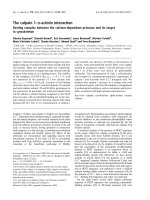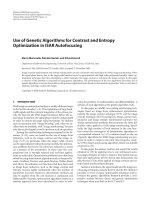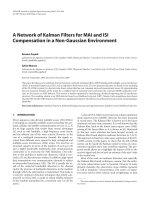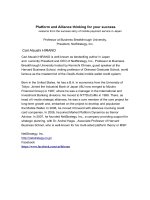A success story of farmer’s using vermicomposting for revenue and employment generation in trans-himalyas of cold arid region
Bạn đang xem bản rút gọn của tài liệu. Xem và tải ngay bản đầy đủ của tài liệu tại đây (348.86 KB, 6 trang )
Int.J.Curr.Microbiol.App.Sci (2019) 8(4): 1283-1288
International Journal of Current Microbiology and Applied Sciences
ISSN: 2319-7706 Volume 8 Number 04 (2019)
Journal homepage:
Original Research Article
/>
A Success Story of Farmer’s using Vermicomposting for Revenue and
Employment Generation in Trans-Himalyas of Cold Arid Region
Jigmet Yangchan*, S.A. Ganie, M.A. Wani, V. Gupta, Anil Kumar and Yogesh Kumar
High Mountain Arid Agriculture Research Institute, Leh (SKUAST-Kashmir), India
*Corresponding author
ABSTRACT
Keywords
Vermicompost,
Worms, Humus,
Soil, Micronutrient,
Cattle dung
Article Info
Accepted:
10 March 2019
Available Online:
10 April 2019
Vermicompost is a fine granular, dark brown/black coloured organic product prepared by
earthworms by using animal dung and organic wastes which is much useful for soil health.
It has biological properties as rich in population of soil micro-organisms compared with
those in conventional composts. Vermicompost has adequate amount of micronutrient and
macronutrients depending on sources of earthworm’s feedstock. Earthworm promotes soil
fragmentation and increase aeration of soil by volume 8-30 per cent. Vermicompost has at
least four times more plant nutrients than conventional cattle dung compost.
Vermicomposting is a source of creating self employment and revenue generation. This is
an easy and faster process of converting organic matter into compost than other
conventional methods. A farmer, Shri Skalzang Tundup adopted vermicomposting for his
livelihood and started from a very small scale and became a successful producer of quality
product. He argued that his product is demanded by nearby farmers, NGO’s and
government organizations of Ladakh. Moreover, he is encouraging interested farmers to
prepare this multifunctional quality product on their own farms so that farming community
can be benefitted.
Introduction
Vermicompost is an organic fertilizer
obtained from the earthworms by passing out
the organic wastes through the digestive
systems. The process of preparation of this
organic fertilizer may be called as
vermicomposting. Earthworm improves and
restores soil fertility and boost up crop
productivity by the use of their excretory
products known as vermicast. Vermicast is
popularly known as Black gold because of
rich in nutrients, growth promoting
substances, beneficial soil micro flora, having
properties of inhibiting pathogenic microbes
and synergistic relationship in plant
rhizospheres. Being stable, multifunctional
organic manure which enriches the soil
quality by improving physio-chemical and
biological properties it must be promoted
(Datta et al., 2016). Vermicompost is
becoming popular day by day as it provides
quality products through major component of
organic farming system (Yadav et al., 2013).
Mixture of leguminous and non-leguminous
crop residues enriches the quality of
vermicompost. Its moisture content remains
in between 45- 65% which is ideal for land
1283
Int.J.Curr.Microbiol.App.Sci (2019) 8(4): 1283-1288
applied compost and pH values near neutral
due to the production of CO2 and organic
acids. Other by products of microbial
activities is also known which promote plant
growth, disease antagonists and growth
influencing substance like hormones.
Vermicompost is a safe, non-polluting and
one of the most economical and convenient
way of solving the waste disposal problems
and recycling of organic waste. It is an
excellent form of natural manure which is
cost effective, easy to make, handling and
contain high nutrients with growth hormones
and are 4-5 times powerful growth promoter
than all other organic fertilizers and over 3040% higher than the chemical fertilizer
(Narkhede et al., 2011, Attarde et al., 2012).
Various workers reported that vermicompost
contain 17-36 % Humic acid and 13-30%
Fulvic acid of total concentration of organic
matter. Besides, vermicompost has an
adequate amount of micronutrient and
macronutrients depend on sources of
feedstock. Earthworms and vermi-compost
can promote growth 50-100 per cent than
compost and 30-40 per cent over chemical
fertilizers (Sinha et al., 2010). Keeping in
view the above facts and properties of
vermicompost Mr. Skalzang Tundup a
progressive farmer, adopted it as an
occupation for his livelihood and generated
employment for numerous agro farmers of
nearby areas.
Materials and Methods
Success story of Skalzang Tundup
Sri Skalzang Tundup S/o Tsering Angchok,
born in1969 and completed his education up
to Matric, is resident of Thiksey village under
Leh Tehsil of Leh district in Jammu &
Kashmir, India. He opted the Agriculture
occupation for his livelihood after got
retirement from army. He came in contact
with High Mountain Arid Agriculture
Research Institute (HMAARI), SKUAST-K
Leh in the year 2018 during Skill
development programme of vermicompost.
Till then he had been cultivating traditional
crops of wheat, barley and some vegetable on
a usual pattern and applied chemical fertilizer.
After coming in contact with HMAARI
scientists he started his own vermicompost
unit at large scale on scientific basis. In the
meantime he undertook training on
vermicompost production, and this center
supplied 7 bags of plastic vermibed and
worms to this farmer to encourage his work,
today with this setup of technology he is
receiving more demand of vermicompost not
only from line departments but also from
farmers and hotel owners. Within one bag he
earned Rs 20000/= in four months. After
getting training and vermibags from
HMAARI SKUAST-K Leh he earned around
Rs 4 20,000 /=. Now he is willing to spread
his business to large scale.
He is having his own agriculture land and a
dairy farm with 12 cattles. He is also
interested in raising crops in an organic way
after successful capacity building through this
training programme. Thiksey village soil is
not so good because of salinity and hard crust
and he is very satisfied with this technology
because he is not only securing his livelihood
but also sets an example for coming
generation as well as for farmers community
of Thiksey. Now he has become a role model
for Thiksey village in the field of Agriculture.
Beside that he received Award from
Agriculture department during Kissan Mela
29/8/18.
Adopted preparation method
Earthworm, also called angleworm, any one
of more than 1,800 species of terrestrial
worms of the class Oligochaeta (phylum
Annelida)—in particular, members of the
1284
Int.J.Curr.Microbiol.App.Sci (2019) 8(4): 1283-1288
genus Lumbricus. Seventeen native species
and 13 introduced species (from Europe)
occur in the eastern United States, L terrestris
being the most common. Earthworms occur in
virtually all soils of the world in which the
moisture and organic content are sufficient to
sustain them. One of the most detailed studies
of earthworm activities was conducted by
English naturalist Charles Darwin. Some
studies said that there are about 240 species of
generally worms worldwide, among them
about 50 species are available in India. On the
basis of habitat, worms can be categorized
into three groups:
Epizoic
It is known as manure worms or compost
worms which have short life span and rapid
breeding ability. Epizoic worms obtain their
food from upper surface of half decomposed
organic matter and move downward. Eisenia
foetida (Red earthworm), Eudrilus eugeniae
(night crawler), Perionyx excavatus etc. are
under this group. Eisenia foetida is selected
because of its high multiplication rate and
converts abundant amount of organic wastes
into vermicompost. Red earthworm have
body length 3-10cm, body weight 0.4-0.6g,
maturity 50-55days, conversion rate 2.0
q/1500worms/2 months, cocoon production 1
in every 3 days and incubation period is 2023days.
Endozoic
Endozoic worms, known as field worm,
consume food from lower portion and prefer
soil than organic matter. Endozoic worm help
in churning of soil, air circulation in soil and
mixing of organic matter
Anesic
Anesic form hole and stay in it. Lives of
anesic are very complex and prefer leaves.
Vermicomposting unit size (1.50cm X 1.30
cm X 70cm) was established in a warm place
under Ladakh condition where temperature
goes to -300C to +350C. Number of units
increased according to availability of raw
materials and requirements. Cow dung and
chopped dried leafy materials were mixed in
the proportion of 3: 1 and kept for 20-30 days
for partial decomposition. During this period,
heap was kept moist by sprinkling of water so
that temperature can be favorable to worms.
A layer of 15-20cm of chopped dried
leaves/grasses was kept as bedding material at
the bottom of the bed. Each bed contained 45q of raw material. Now 1500-2000 Red
earthworms were released on the upper layer
of the bed and covered with gunny
bags/paddy straw so that worms can be saved
from predators. Water was sprinkled
immediately after releasing worms and it was
kept moist by frequent sprinkling as per need.
Bed was turned once after 15-20 days for
maintaining
aeration
and
proper
decomposition. A reddish colour liquid, with
an alkaline reaction having dissolved
nutrients, called vermiwash was collected in
the small chamber connected through
drainage pipes fitted at the bottom of the tank.
By this way vermicompost was ready in
4months and amounting by 350-450 kg were
harvested from one bag. Moreover,
vermiwash was additional product which was
abundant in nutrition having plant growth
hormones, micronutrients and organic acids.
For value addition of vermicompost, rock
phosphate, azolla etc. was added accordingly.
Preventive measures during production
Selection of site was most important
according to purpose of production either
commercial or personal.
Producer was trained by scientists of High
Mountain Arid Agriculture Research Institute
SKUAST-K Leh before start the production.
At least 30 day’s old cow dung used to avoid
1285
Int.J.Curr.Microbiol.App.Sci (2019) 8(4): 1283-1288
excess heat.
Avoid fresh dung and waste because worms
would die in fresh cow dung.
The organic wastes were free from,
chemicals, pesticides and metals etc.
Aeration was maintained for proper growth
and multiplication of earthworms.
Optimum moisture level (50-60 %) and
temperature 25-320C (Sharma, 2009) was
maintained for proper functioning of worms.
Ants are dangerous enemy of worms, so
charcoal powder was mixed to the raw
materials to escape from them.
Activities of worms were monitored
frequently for producing quality produce.
All works from production to packaging was
done in shade and the products were stored in
shade and one kg poly bags or 50 kg poly
bags were used for marketing.
Results and Discussion
The success of any production system
basically depend on need, availability of
inputs and marketing channels by which one
can get the remunerative price by using
locally available resources. The key to the
success of organic farming system is the
production of all inputs like, manures, plant
protection etc., and on-farm utilizing the local
resources wherein animal husbandry plays a
catalytic role. The study on economics of
vermicompost production indicated that it is
50-57% economical enterprise as compared to
costly chemical fertilizers. Direct marketing
of vermicompost from producer to consumer
was found to be strongest marketing channel,
however marketing through cooperatives and
trader was also found in few instances.
Economics of vermicompost production was
carried out in Coorg district of southern
Karnataka, India to compare benefit cost ratio
and observed 1.78 and 1.52 for wet method
and heap method, respectively (Reddy et al.,
2009). Specialized market for vermicompost
was not observed in the study area but
obvious that about 85 % vermicompost was
marketed directly from producers to local
consumers. It is essential to clearly define a
national policy on organic farming by
supporting private sector groups, NGOs or
associations, and encouraging farmers to
produce their own fertilizer in respective
country (Ranaivoarisoa et al., 2016).
Data collected from farmer’s field and its
statistics is depicted in (Table 1) which
clearly indicated that benefit and cost ratio is
1:2.4 which is profitable enough for farmers
(Fig. 1–3).
Table.1 Cost:Benefit ratio of vermicompost
Cost of
vermicompost
production per
bag in 4 month
(Rs.)
18000
Gross
Income(Rs)
Net
Income(Rs)
Per bag
B.C.
Ratio
126000
7500
1:2.4
1286
Total -7 unit
working, 450kg/unit were
produce ,total compost
produced-3150kg, sale
of vermicompost@400/Kg
Int.J.Curr.Microbiol.App.Sci (2019) 8(4): 1283-1288
Fig.1
Fig.2
Fig.3
1287
Int.J.Curr.Microbiol.App.Sci (2019) 8(4): 1283-1288
By this case study it can be concluded that
farmers like Mr. Skalzang Tundup adopted
vermicompost production, enhanced his
livelihood status, improved soil health and
conserved beneficial soil micro-organisms.
He argued himself by his quality product
which is demanded by nearby farmers,
NGO’s and government organizations of
Ladakh. Moreover, he is encouraging
interested
farmers
to
prepare
this
multifunctional quality product on their own
farms so that farming community can be
benefitted. Data collected from farmer’s field
indicated that benefit and cost ratio (1:2.4) is
significantly higher and can boost-up Ladakh
economy which is today’s essential need.
Acknowledgement
I am highly obliged to the High Mountain
Arid
Agriculture
Research
Institute
SKUAST-K Leh for providing opportunity to
farmers who adopted scientific methods of
vermicomposting for their self employment.
References
Attarde, S.B., S.D. Narkhede, R.P. Patil, and
Ingle, S.T. 2012. Effect of organic and
inorganic fertilizers on the growth and
nutrient content of Abelmoschus
esculentus (okra crop). International J.
of current research. 4(10): 137-140.
Charles
Robert
Darwin
/>Charles-Darwin
Datta, S., J. Singh, S. Singh, and Singh, J.
2016. Earthworms, pesticides and
sustainable agriculture: a review.
Environmental Science and Pollution
Research. 23(9): 8227–8243
/>Narkhede, S.D., S.B. Attarde, and Ingle, S.T.
2011. Study on effect of chemical
fertilizer and vermicompost on growth
of chilli pepper plant (Capsicum
annum). Journal of applied sciences in
environment sanitation. 6 (3): 327-332.
Ranaivoarisoa, H., S. Ravoninjiva, S.
Ramananarivo, and Ramananarivo, R.
2016. Vermiculture for Sustainable
Organic Agriculture in Madagascar.
Horticulturae. 3(2): 1-8.
Reddy, B.V., C. Honnaiah, P.N.S. Reddy,
R.D. Kale, and Balakrishna, A.N. 2009.
Economics of vermicompost production
and marketing in Southern Karnataka,
Mysore J. Agric. Sci. 43(1): 125-131.
Sharma, A.K. 2009. Vermiculture in
Biofertilizers
for
Sustainable
Agriculture. Agrobios India., 41-66.
Sinha, R.K., S. Agarwal, K. Chauhan, and
Valani, D. 2010. The wonders of
earthworms & its vermicompost in farm
production: Charles Darwin’s ‘friends of
farmers’, with potential to replace
destructive chemical fertilizers from
agriculture. Agricultural Science. 1(2):
76-94.
Yadav, S.K., S. Babu, M.K. Yadav, K. Singh,
G.S. Yadav, and Pal, S. 2013. A review
of organic farming for sustainable
agriculture
in
northern
India.
International Journal of Agronomy,
2013, Article ID 718145.
How to cite this article:
Jigmet Yangchan, S.A. Ganie, M.A. Wani, V. Gupta, Anil Kumar and Yogesh Kumar. 2019. A
Success Story of Farmer’s using Vermicomposting for Revenue and Employment Generation
in Trans-Himalyas of Cold Arid Region. Int.J.Curr.Microbiol.App.Sci. 8(04): 1283-1288.
doi: />
1288









